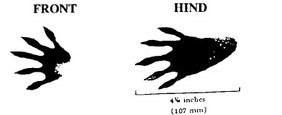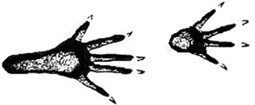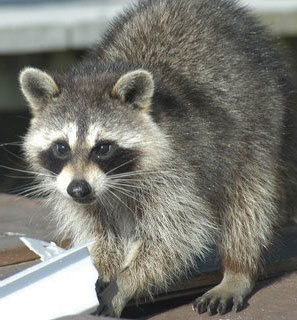Wildlife removal in Wisconsin can mean many things, from something in your wall or attic to a guest under your porch. In order to determine what small animal made its way into your personal space, there are a couple of clues you can look for based on the habits, diet and activity of each. See the eight most common animals that Batzner runs into throughout Wisconsin:
1. Raccoon |
 |
| Diet | Opportunistic eaters and will eat whatever they can find, including fruits, veggies, small animals, and garbage. |
| Shelter/Entry | Raccoons can enter through open garage doors, chimneys that don’t have a cap, attic fans, roof vents, and open soffits. Not usually found in basements. |
| Offspring | Generally give birth to 1 litter per year during April and June. The litter is typically 3-5 young that stay with their mother for about 7 weeks. |
| Most active time | Nocturnal, and if they are seen active during the day, it may indicate that the animal is sick. |
| Removal | Live trapping with marshmallows, opened canned tuna, aluminum foil as attractant is recommended. |
2. Squirrel |
 |
| Diet | Nuts, seeds and vegetation. |
| Shelter/Entry | Frequently found in openings of soffits and overhanging trees allowing rooftop access. Because of this they are more commonly found in attics, rather than basements. |
| Offspring | 2 litters per year – one between February and April and one between August and September. Each litter has 2-6 young. |
| Most active time | Most active during early morning and late afternoon. |
| Removal | Live trapping with walnuts, hazelnuts, peanuts, sunflower seeds. |
3. Opossum |
 |
| Diet | Fruit, snakes, insects, and trash. |
| Shelter/Entry | Use existing openings under slabs or porches, open garages, not usually found in basements. Opossums don’t dig but will take over openings and holes from other animals. |
| Offspring | Normally 5-8 young in a litter (could be up to 25), breed one time per year during February through June. |
| Most active time | Nocturnal. |
| Removal | Transient animals and may move on after a couple of days. If necessary, live trapping can be done with canned cat food or apples. |
4. Rabbit |
 |
| Diet | Vegetation, veggies, grass, and herbs. |
| Shelter/Entry | Rabbits usually place their nests in plain view, sometimes in the middle of a yard, brush piles, or long grass with fur over and around the nest. Not usually found indoors. |
| Offspring | Typically have 3 litters per year with an average of 7 babies per litter – very few make it to maturity. |
| Most active time | Dawn and dusk. |
| Removal | Live trapping with brussel sprouts, carrots and lettuce. |
5. Skunk |
 |
| Diet | Small mammals, eggs, fruit, berries, insects, food scraps in trash, and dog feces. |
| Shelter/Entry | Under decks, burrows, under sheds, wood or rock piles, not usually found indoors. |
| Offspring | 5-6 young in April-June. |
| Most active time | Nocturnal. |
| Removal | Live trapping and/or covered trap baited with cat food, chicken entrails or sardines with brussel sprouts, carrots or lettuce. |
6. Woodchuck/Groundhog |
 |
| Diet | Herbivores eating a variety of green plants and flowers doing damage to gardens and flower beds. |
| Shelter/Entry | Typically burrow underneath something such as a porch, deck or slab. Burrows could have between 2-10 entrances. |
| Offspring | One litter per year of 4-5 young, born usually in April or May. |
| Most active time | Daytime, especially early morning and late afternoon. |
| Removal | Live trapping with vegetables, cantaloupe, sweet corn, lettuce, canned peaches or fruit cocktail. Trap needs to be set early morning before the groundhog comes out. Groundhogs will have secondary openings that need to be blocked off to funnel the groundhog in the trap from the main burrow. |
7. Rat |
 |
| Diet | Eat anything they can find, including garbage scraps, and insects. |
| Shelter/Entry | Burrows, attics, walls, under slabs and porches. Can fit into openings the size of a quarter. |
| Offspring | Breed year round (up to 5 litters per year) with 6-24 babies per litter. |
| Most active time | Nocturnal. |
| Removal | Exclusion, burrow baiting, and snap traps. |
8. Muskrat |
 |
| Diet | Cattails and other aquatic vegetation. |
| Shelter/Entry | Build lodges similar to beavers in river and stream banks. |
| Offspring | 2-3 litters per year with 6-8 young each. |
| Most active time | Mostly nocturnal or near dawn or dusk. |
| Removal | Live trapping with fresh vegetables, carrots or apples. |
*It is important to note that if there is muskrat problem, there will be some type of body of water nearby.

